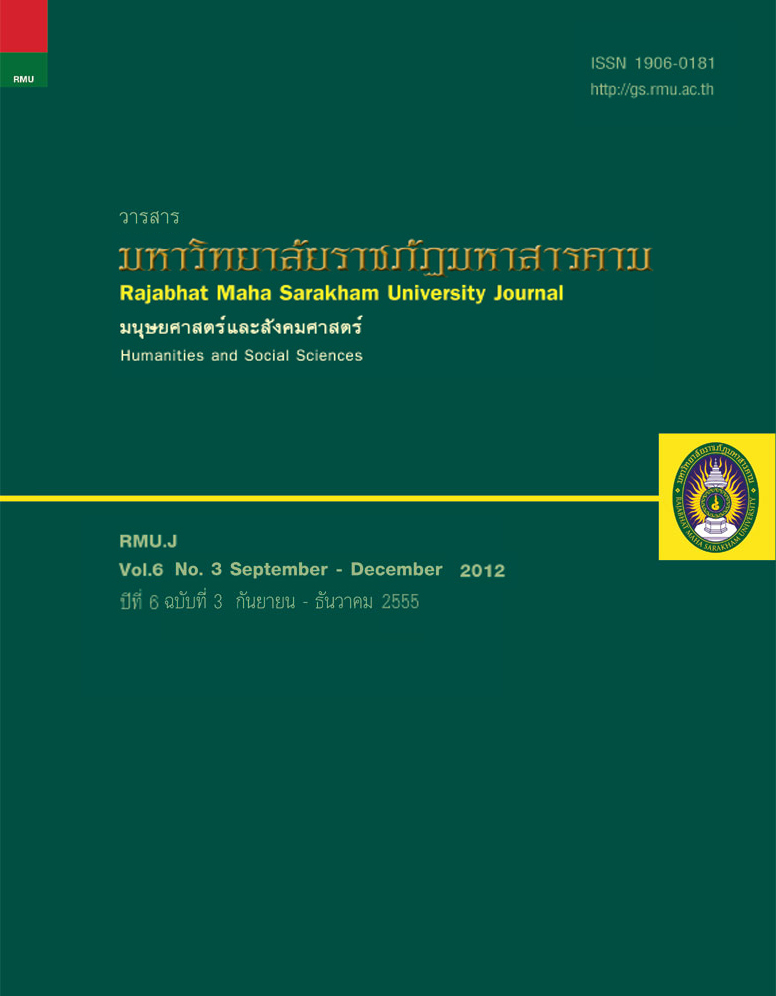การสร้างแบบทดสอบวินิจฉัยวิชาคณิตศาสตร์ เรื่อง อัตราส่วนและร้อยละ ชั้นมัธยมศึกษาปีที่ 2
Main Article Content
บทคัดย่อ
บทคัดย่อ
การวิจัยครั้งนี้มีวัตถุประสงค์เพื่อสร้างแบบทดสอบวินิจฉัยข้อบกพร่องในการเรียนวิชาคณิตศาสตร์ เรื่อง อัตราส่วนและร้อยละ ชั้นมัธยมศึกษาปีที่ 2 ชนิดเลือกตอบ 4 ตัวเลือก จำนวน 3 ฉบับ คือ ฉบับที่ 1 วัดทักษะการคิดคำนวณ ฉบับที่ 2 วัดทักษะการให้ เหตุผล และฉบับที่ 3 วัดทักษะการแก้ปัญหา กลุ่มตัวอย่างที่ใช้ในการวิจัยเป็นนักเรียนชั้นมัธยมศึกษาปีที่ 2 ปีการศึกษา 2553 สังกัด สำนักงานเขตพื้นที่การศึกษามัธยมศึกษา เขต 26 จำนวน 514 คน จากโรงเรียน 10 โรงเรียน ซึ่งได้มาจากการสุ่มแบบหลายขั้นตอน (Multi-stage random sampling) วิธีดำเนินการสร้างแบบทดสอบวินิจฉัย ได้ทำการทดสอบ 3 ครั้ง ครั้งที่ 1 และครั้งที่ 2 เพื่อ ปรับปรุงและคัดเลือกข้อสอบ การทดสอบครั้งที่ 3 เพื่อหาคุณภาพของแบบทดสอบ และ หาข้อบกพร่องในการเรียน วิชาคณิตศาสตร์ เรื่อง อัตราส่วนและร้อยละ การทดสอบ 3 ครั้ง ดังกล่าว ได้มาจากแบบทดสอบเพื่อสำรวจ ซึ่งเป็นข้อสอบชนิดเติมคำตอบ และแสดง วิธีทำ เพื่อรวบรวมคำตอบผิดมาเป็นตัวลวงในแบบทดสอบวินิจฉัยข้อบกพร่อง จำนวน 1 ฉบับ มี 3 ตอน รวม 60 ข้อ ผลการวิจัยพบว่า
1. แบบทดสอบ วัดทักษะการคิดคำนวณ มีข้อสอบจำนวน 25 ข้อ มีค่าความยากตั้งแต่ .25 ถึง .80 ค่าอำนาจจำแนกตั้งแต่ .22 ถึง .98 ความเชื่อมั่นเท่ากับ .89
2. แบบทดสอบ วัดทักษะการให้เหตุผล มีข้อสอบจำนวน 15 ข้อ มีค่าความยากตั้งแต่ .22 ถึง .80 ค่าอำนาจจำแนกตั้งแต่ .25 ถึง .78 ความเชื่อมั่นเท่ากับ .83
3. แบบทดสอบ วัดทักษะการแก้ปัญหา มีข้อสอบจำนวน 20 ข้อ มีค่าความยากตั้งแต่ .20 ถึง .65 ค่าอำนาจจำแนกตั้งแต่ .20 ถึง .83 ความเชื่อมั่นเท่ากับ .83
ค่าความเที่ยงตรงเชิงเนื้อหาของแบบทดสอบจากการพิจารณาของผู้เชี่ยวชาญทางด้านเนื้อหาพบว่า แบบทดสอบทั้ง 3 ฉบับ เป็น แบบทดสอบที่มีคุณภาพสามารถวัด เรื่องอัตราส่วนและร้อยละได้จริง ได้ค่า IOC มีค่าตั้งแต่ .80 ถึง 1.00 สิ่งที่นักเรียนบกพร่องมาก ที่สุดคือ ทักษะการคิดคำนวณที่เกิดจากการไม่รอบคอบในการคิดคำนวณ รองลงมาคือ ความบกพร่องที่เกิดจากความไม่เข้าใจวิธีหา ตัวแปรในสัดส่วน และ ความบกพร่องที่เกิดจากการคำนวณอัตราส่วนผิด ตามลำดับ
คำสำคัญ : การสร้างแบบทดสอบวินิจฉัย, ข้อบกพร่องในการเรียนวิชาคณิตศาสตร์, อัตราส่วนและร้อยละ
ABSTRACT
Mathematics is a subject with its important role in developing learners who have different knowledge, skills, and abilities in logical problem-solving and decision-making. However, it has been found recently that learners still lack knowledge and understanding of mathematics contents, leading to unsatisfactory learning outcomes. The failure in the learning outcomes was caused by the teachers, but the cause for inadequate understanding has not been identified yet.
The purpose of this research was to construct a mathematics diagnostic test on the ratio and the percentage for 8th Grade students. The test type was a multiple-choice with a four-rating scale. The diagnostic test comprised 3 subtests on computational skills, reasoning skills and problem-solving skills. The sample group of this research was 514 students studying in 10 secondary schools under the Secondary Educational Service Area Office 26 in the academic year of 2010. The Multi-Stage Random Sampling was used to get the sample subjects. The test construction procedures were divided into three stages; The first two stages were for selection and improvement of the test items; the third stage was to assess the test quality and diagnose the students’ abilities in learning the ratio and the percentage.
The results were shown as the follows:
1. The first test on computational skills had 25 items having the level of the difficulty from .25 - .80 ; the discrimination power from .22 - .98 and the reliability coefficient at .89.
2. The second test on reasoning skills had 15 items having the level of the difficulty from .22 - .80 ; the discrimination power from .25 - .78 and the reliability coefficient at .83.
3. The third test on problem- solving skills had 20 items having the level of the difficulty from .20 - .65 ; the discrimination power from .20 - .83 and the reliability coefficient at .83.
According to the experts, the content validity of the three tests was qualified to be used to assess the abilities in mathematics regarding the ratio and the percentage. The IOC values ranged from .80-1.00. Most of the shortcomings found in the students’ learning were caused by their careless computation, inadequate understanding in finding variables in the ratio and wrong calculation of the ratios respectively.
Keyword : Construction of Diagnostic Test, Mathematics Diagnostic Test, Ratio and Percentage
Article Details
1. บทความที่ลงตีพิมพ์ทุกเรื่องได้รับการตรวจทางวิชาการโดยผู้ประเมินอิสระ ผู้ทรงคุณวุฒิ (Peer Review) สาขาที่เกี่ยวข้อง อย่างน้อย 3 ท่าน ในรูปแบบ Double blind review
2. ข้อคิดเห็นใด ๆ ของบทความที่ลงตีพิมพ์ในวารสารมหาวิทยาลัยราชภัฏมหาสารคาม นี้เป็นของผู้เขียน คณะผู้จัดทำวารสารไม่จำเป็นต้องเห็นด้วย
3. กองบรรณาธิการวารสารมหาวิทยาลัยราชภัฏมหาสารคาม ไม่สงวนสิทธิ์การคัดลอกแต่ให้อ้างอิงแสดงที่มา

